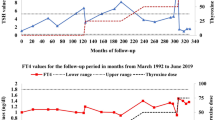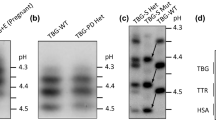Abstract
Purpose
T4-binding globulin (TBG) is the main thyroid hormone (TH) transporter present in human serum. Inherited thyroxine-binding globulin (TBG) deficiency is caused by mutations in the TBG (SERPINA7) gene, which is located on the X chromosome. This study was performed to report and evaluate coding region mutations in TBG gene for partial thyroxine-binding globulin deficiency.
Methods
A pedigree spanning four generations is described in this study. The proband is a female with partial TBG deficiency. All members of this pedigree underwent thyroid function tests, while Sanger sequencing was used to identify the TBG gene mutations. Bioinformatics databases were used to evaluate the deleterious effects of the mutation(s). Two hundred and seven unrelated individuals were used to evaluate the thyroid function of individuals with different TBG mutations. A one-way ANOVA was used to analyze the impact of the TBG mutations on thyroid function.
Results
TBG gene sequencing results revealed that the proband had a novel mutation in codon 27 leading to alanine to valine substitution (p.A27V). This mutation was associated with lower serum T4 levels (p < 0.0001) when compared to the groups that did not carry the mutation. The previously reported p.L283F mutation was also found in the proband. The hemizygous p.L283F individuals presenting with lower T4 serum and TBG levels (p < 0.001) when compared to wildtype males and females. Both mutations were deleterious upon SIFT and PolyPhen-2 evaluation.
Conclusion
Associated with partial thyroxine-binding globulin deficiency, this study reports a novel p.A27V mutation in the TBG gene.


Similar content being viewed by others
Availability of data and material
The data that support the findings of this study are available from the corresponding author upon reasonable request.
References
Oppenheimer JH (1968) Role of plasma proteins in the binding, distribution and metabolism of the thyroid hormones. N Engl J Med 278(21):1153–1162. https://doi.org/10.1056/NEJM196805232782107
Mori Y, Miura Y, Oiso Y, Hisao S, Takazumi K (1995) Precise localization of the human thyroxine-binding globulin gene to chromosome Xq22.2 by fluorescence in situ hybridization. Hum Genet 96(4):481–482. https://doi.org/10.1007/bf00191811
Refetoff S (1989) Inherited thyroxine-binding globulin abnormalities in man. Endocr Rev 10(3):275–293. https://doi.org/10.1210/edrv-10-3-275
Yamamori I, Mori Y, Seo H, Hirooka Y, Imamura S, Miura Y, Matsui N, Oiso Y (1991) Nucleotide deletion resulting in frameshift as a possible cause of complete thyroxine-binding globulin deficiency in six Japanese families. J Clin Endocrinol Metab 73(2):262–267. https://doi.org/10.1210/jcem-73-2-262
Dussault JH, Morissette J, Letarte J, Guyda H, Laberge C (1978) Modification of a screening program for neonatal hypothyroidism. J Pediatr 92(2):274–277. https://doi.org/10.1016/s0022-3476(78)80024-9
Fisher DA, Dussault JH, Foley TP, Klein AH, LaFranchi S, Larsen PR, Mitchell ML, Murphey WH, Walfish PG (1979) Screening for congenital hypothyroidism: results of screening one million North American infants. J Pediatr 94(5):700–705. https://doi.org/10.1016/s0022-3476(79)80133-x
Flink IL, Bailey TJ, Gustafson TA, Markham BE, Morkin E (1986) Complete amino acid sequence of human thyroxine-binding globulin deduced from cloned DNA: close homology to the serine antiproteases. Proc Natl Acad Sci USA 83(20):7708–7712. https://doi.org/10.1073/pnas.83.20.7708
Mimoto MS, Refetoff S (2020) Clinical recognition and evaluation of patients with inherited serum thyroid hormone-binding protein mutations. J Endocrinol Invest 43(1):31–41. https://doi.org/10.1007/s40618-019-01084-9
Mannavola D, Vannucchi G, Fugazzola L, Cirello V, Campi I, Radetti G, Persani L, Refetoff S, Beck-Peccoz P (2006) TBG deficiency: description of two novel mutations associated with complete TBG deficiency and review of the literature. J Mol Med 84(10):864–871. https://doi.org/10.1007/s00109-006-0078-9
Su CC, Wu YC, Chiu CY, Won JG, Jap TS (2003) Two novel mutations in the gene encoding thyroxine-binding globulin (TBG) as a cause of complete TBG deficiency in Taiwan. Clin Endocrinol 58(4):409–414. https://doi.org/10.1046/j.1365-2265.2003.01730.x
Mori Y, Takeda K, Charbonneau M, Refetoff S (1990) Replacement of Leu227 by Pro in thyroxine-binding globulin (TBG) is associated with complete TBG deficiency in three of eight families with this inherited defect. J Clin Endocrinol Metab 70(3):804–809. https://doi.org/10.1210/jcem-70-3-804
Reutrakul S, Janssen OE, Refetoff S (2001) Three novel mutations causing complete T(4)-binding globulin deficiency. J Clin Endocrinol Metab 86(10):5039–5044. https://doi.org/10.1210/jcem.86.10.7916
Janssen OE, Astner ST, Grasberger H, Gunn SK, Refetoff S (2000) Identification of thyroxine-binding globulin-San Diego in a family from Houston and its characterization by in vitro expression using Xenopus oocytes. J Clin Endocrinol Metab 85(1):368–372. https://doi.org/10.1210/jcem.85.1.6317
Takeda K, Mori Y, Sobieszczyk S, Seo H, Dick M, Watson F, Flink IL, Seino S, Bell GI, Refetoff S (1989) Sequence of the variant thyroxine-binding globulin of Australian aborigines. Only one of two amino acid replacements is responsible for its altered properties. J Clin Invest 83(4):1344–1348. https://doi.org/10.1172/JCI114021
Bertenshaw R, Takeda K, Refetoff S (1991) Sequencing of the variant thyroxine-binding globulin (TBG)-Quebec reveals two nucleotide substitutions. Am J Hum Genet 48(4):741–744
Janssen OE, Bertenshaw R, Takeda K, Weiss R, Refetoff S (1992) Molecular basis of inherited thyroxine-binding globulin defects. Trends Endocrinol Metab 3(2):49–53. https://doi.org/10.1016/1043-2760(92)90043-z
Adzhubei IA, Schmidt S, Peshkin L, Ramensky VE, Gerasimova A, Bork P, Kondrashov AS, Sunyaev SR (2010) A method and server for predicting damaging missense mutations. Nat Methods 7(4):248–249. https://doi.org/10.1038/nmeth0410-248
Kumar P, Henikoff S, Ng PC (2009) Predicting the effects of coding non-synonymous variants on protein function using the SIFT algorithm. Nat Protoc 4(7):1073–1081. https://doi.org/10.1038/nprot.2009.86
Rentzsch P, Witten D, Cooper GM, Shendure J, Kircher M (2019) CADD: predicting the deleteriousness of variants throughout the human genome. Nucleic Acids Res 47(D1):D886–D894. https://doi.org/10.1093/nar/gky1016
Lek M, Karczewski KJ, Minikel EV, Samocha KE, Banks E, Fennell T, O'Donnell-Luria AH, Ware JS, Hill AJ, Cummings BB, Tukiainen T, Birnbaum DP, Kosmicki JA, Duncan LE, Estrada K, Zhao F, Zou J, Pierce-Hoffman E, Berghout J, Cooper DN, Deflaux N, DePristo M, Do R, Flannick J, Fromer M, Gauthier L, Goldstein J, Gupta N, Howrigan D, Kiezun A, Kurki MI, Moonshine AL, Natarajan P, Orozco L, Peloso GM, Poplin R, Rivas MA, Ruano-Rubio V, Rose SA, Ruderfer DM, Shakir K, Stenson PD, Stevens C, Thomas BP, Tiao G, Tusie-Luna MT, Weisburd B, Won HH, Yu D, Altshuler DM, Ardissino D, Boehnke M, Danesh J, Donnelly S, Elosua R, Florez JC, Gabriel SB, Getz G, Glatt SJ, Hultman CM, Kathiresan S, Laakso M, McCarroll S, McCarthy MI, McGovern D, McPherson R, Neale BM, Palotie A, Purcell SM, Saleheen D, Scharf JM, Sklar P, Sullivan PF, Tuomilehto J, Tsuang MT, Watkins HC, Wilson JG, Daly MJ, MacArthur DG (2016) Exome aggregation, analysis of protein-coding genetic variation in 60,706 humans. Nature 536(7616):285–291. https://doi.org/10.1038/nature19057
Funding
This work was supported by the Natural Science Fund of Guangdong, China (2018A0303130186 and 2019A1515010100), the Guangdong Science and Technology Foundation (2019B030316032), the Research Fund for the Distinguished Young Teachers to Liang Li of Southern Medical University, and Southern Medical University Innovation Training Program for Undergraduate Students (201812121005).
Author information
Authors and Affiliations
Corresponding authors
Ethics declarations
Conflict of interest
The authors declare that they have no conflict of interest.
Ethical approval
All procedures performed in studies involving human participants were in accordance with the ethical standards of the institutional and/or national research committee and with the 1964 Helsinki Declaration and its later amendments or comparable ethical standards.
Informed consent
Informed consent was obtained from all individual participants included in the study.
Additional information
Publisher's Note
Springer Nature remains neutral with regard to jurisdictional claims in published maps and institutional affiliations.
Rights and permissions
About this article
Cite this article
Chen, LD., Lu, HJ., Gan, YL. et al. Partial thyroxine-binding globulin deficiency in a family with coding region mutations in the TBG gene. J Endocrinol Invest 43, 1703–1710 (2020). https://doi.org/10.1007/s40618-020-01245-1
Received:
Accepted:
Published:
Issue Date:
DOI: https://doi.org/10.1007/s40618-020-01245-1




